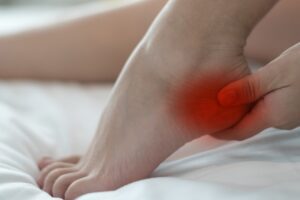A bone spur refers to a hard-textured growth that forms along the edge of bone near a joint. Many people can develop these spurs in the feet, especially near the heel. Small spurs might not cause any symptoms or disruptions in your life. But they can become painful and interfere with your mobility over time.
A podiatrist can treat bone spurs in the feet with physical therapy and non-invasive treatments, like orthotics or splints, in most cases. But it can help to know if you have a higher risk of forming these bone deformities in the feet. Read on to learn about three risk factors that may make you more likely to develop bone spurs in your feet.

Older Age
Bone spurs take a great deal of time to grow, so people tend to get them when they get older. If you have a family history of relatives getting bone spurs, you will have a higher chance of forming them as well. Pay attention to your foot health and take care of your feet to protect them from this condition.
In rare occasions, bone spurs can occur for congenital reasons, health issues present at birth. But more likely, bone spurs form when cells near the bones begin to sustain damage and resulting swelling can encourage bone growths that become spurs. Call your podiatrist to learn more about your chances of developing spurs in your feet.
Chronic Illnesses
Bone spurs can often form in conjunction with other health issues with the feet. For instance, tendonitis or arthritis will create inflammation and other damage in joints. Then this promotes cell growth that may lead to bone spurs.
Other chronic health concerns can generate systemic inflammation, including diabetes. Work with your doctor to manage chronic health concerns and reduce your chances of forming bone spurs. Consult with a podiatrist to learn how existing conditions can impact your foot health.
Prior Foot Injuries
If you suffered an injury to your feet or ankles in the past, this could put you in danger of forming bone spurs later in life. As mentioned, the body’s reaction to healing damaged cells, like broken bones, may encourage the formation of spurs along bone.
People who engage in a great amount of physical activity, including high-impact running and dancing, may also run a higher risk of bone spur formation. The constant movement of the joints can eventually wear down tendons and joints. Then this may lead to inflammation that can lead to spur growth.
Engage in balanced amounts of exercise to ensure you stay healthy without overdoing it and risking injuries or bone spurs anywhere on your body. A doctor or podiatrist can help you develop a preventative care plan. This can help you avoid foot deformities like spurs along with other problems with your feet, toes, and ankles. Seek treatment for foot pain promptly to avoid worsening symptoms and discomfort.
